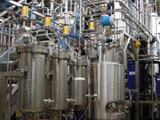Multi-talented enzyme – produced on large-scale
Enzymes remove spots from our laundry, whiten paper and help with brewing beer. To wit: They facilitate many industrial processes. In many cases, enzymes are obtained from fruits. However, if the harvest is poor, this might lead to shortfalls. Researchers therefore designed a process to produce enzymes microbiologically. A multifunctional facility now opening in Leuna should help with adapting these new processes to an industrial scale.
Papayas are delicious and healthy – and they contain papain, an enzyme that is isolated from the fruit and used in countless industries. They are used for brewing beer, the handling of meat products, the treating of wool in the textile industry and the treating of inflammation in the medical field. A similar example is represented by horseradish: Its enzyme – horseradish peroxidase – is used in large quantities in several diagnostic and immunological tests. But the horseradish harvest varies dramatically from year to year. When the harvest is poor, then horseradish peroxidase is no longer available in quantities that the industry needs.
For this reason, the researchers within the “Innozym” project at the Fraunhofer Institute for Interfacial Engineering and Biotechnology IGB in Stuttgart are designing pathways to manufacture enzymes using biotechnology with the aid of microorganisms. The advantage: No matter how the harvest turns out, enzymes can always be sufficiently produced. In addition, the scientists are also creating entirely new enzymes that are intended to replace chemical catalysts. These could make it possible to run industrial operations at lower temperatures and thereby save energy. They could also reduce the usage of process chemicals, such as those used to modulate pH values. In the laboratories, the researchers are producing the enzymes in reaction vessels that can hold a maximum of 30 liters. In the factory, by contrast, the production reactions for enzymes actually start at 10,000 liters. However, one cannot simply apply the same production steps that work for small batches of enzymes to large batches. Even though researchers at the lab could, for example, add expensive substances, this would make large-scale production economically infeasible.
The Fraunhofer Center for Chemical-Biotechnological Processes CBP in Leuna – which belongs to the Fraunhofer IGB and Fraunhofer Institute for Chemical Technologies ICT – is expected to close this gap between laboratory and industry. A multifunctional facility has also been integrated into the new building that is set to open in October. “We are scaling the processes that our colleagues at the IGB developed and optimized in the laboratory – from the 10-liter laboratory-scale to 10,000 liters high. That is often technically a quite different process,” says Dr. Katja Patzsch, group manager of biotechnological processes at CBP. “The emerging multifunctional facility is unlike anything else in Europe.” It was designed and built by the company Linde Engineering Dresden GmbH.
Generally speaking, the manner in which the enzymes are produced remains the same – no matter if large or small batches of enzymes are produced. The researchers are cultivating certain organisms in a culture medium, like yeast cells or bacteria. If sufficient organisms were cultivated, the scientists add an inductor – a substance that stimulates the cells or bacteria to produce the desired enzyme, and then transfer it into the culture medium. The researchers first extract the cells from the fluid. In this respect, the separator can handle any quantity of fluid up to 10,000 liters. In a later step, the scientists fish out the enzyme from the residual suspension – for instance, by crystallizing or filtering the enzyme, or separating it through a chromatography column.
The “Innozym“ project
The “Innozym” project was funded by the German Federal Ministry of Education and Research BMBF. Beside Fraunhofer IGB, project partners also include the Institute for Interfacial Engineering IGVT at the University of Stuttgart as well as the companies c-LEcta GmbH, InfraLeuna GmbH and Linde Engineering Dresden GmbH. A component of the sponsorship also includes the multifunctional facility that Linde Engineering Dresden GmbH constructed as a “Technical Enzyme” module at Fraunhofer CBP. With this module, enzymes, biotransformation processes and the actual enzyme production – including the reprocessing in bacteria and yeast – can be optimized.
 Fraunhofer Center for Chemical-Biotechnological Processes CBP
Fraunhofer Center for Chemical-Biotechnological Processes CBP